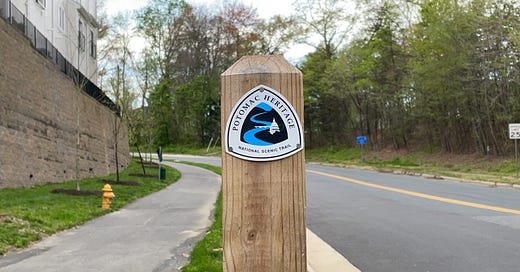New Study Presents Options to Expand the Potomac Heritage National Scenic Trail in Loudoun County
This concludes a year-long planning process, developed with stakeholder and public input, envisioning completion and potential future access to the trail.
The Northern Virginia Regional Commission (NVRC) is pleased to announce the completion of the 2024 Potomac Heritage National Scenic Trail Western Loudoun County Feasibility Study that identifies options to fill a significant gap in the trail in Loudoun County from the Town of Leesburg westward.
This concludes a year-long planning process, developed with stakeholder and public input, envisioning completion and potential future access to the trail.
To view the study, visit https://www.potomacheritagenova.com/loudoun-feasibility-study.
The Potomac Heritage National Scenic Trail (PHNST), administered by the National Park Service, is made up of a diverse network of locally managed trails and routes in Maryland, Pennsylvania, Virginia, and the District of Columbia, spanning a corridor between the mouth of the Potomac River and the Allegheny Highlands in Pennsylvania. There are several trail gaps in the network that need to be completed, including the western Loudoun gap.
Design and planning firm, Lardner/Klein Landscape Architects, was selected to conduct the study in January 2024. In winter and spring 2024, Lardner/Klein developed a methodology to complete an analysis of potential trail routes and conducted initial information meetings with relevant PHNST stakeholders. Over the summer and fall of 2024, Lardner/Klein completed its analysis to identify the feasibility of different route options for completing the network gap.
The study process included several opportunities for community input, including two public meetings in May and October 2024, two online questionnaires, a StoryMap, and individual meetings with specific partners, such as Potomac Heritage Trail Association, Bike Loudoun, and the VDOT State Trails Office, to obtain insights, questions, and other feedback. Community input was an essential aspect of this study, and the results aimed to fully capture stakeholders' questions and input.
The feasibility of developing the trail along the identified sections was evaluated in detail. The consultant identified public and private lands, river access points, and existing roads that could be linked together to form a new section of the trail. All concepts expand public access and provide new recreational opportunities, taking into account trail safety along busy roads, natural and cultural resource protection, and future maintenance and sustainability.
Overall, results of the study present the feasibility of potential routes within the PHNST corridor, including considerations for routes that have limited feasibility or are unfeasible, but these findings primarily represent a starting point for future planning efforts for trail designation. NVRC will continue to coordinate with Loudoun County and the National Park Service to conduct outreach and engagement around the study’s findings and evaluate next steps for determining a connected trail route for the region. Completion of new trail sections will depend on funding, land acquisition, and future design and engineering studies.
To view the Final Report and find additional information on the study, you can visit NVRC’s project webpage. For questions about this study, please contact Rebecca Murphy, NVRC’s Coastal Program Manager, at rmurphy@novaregion.org.
About the Northern Virginia Regional Commission
NVRC is a consortium of thirteen local governments representing more than 2.6 million residents. While only 3% of Virginia's land mass, Northern Virginia has a GDP of $302 Billion which is 42% of the GDP of the Commonwealth of Virginia. Northern Virginia’s GDP is larger than 24 states and the District of Columbia and if a country would be the 48th largest economy in the world.




